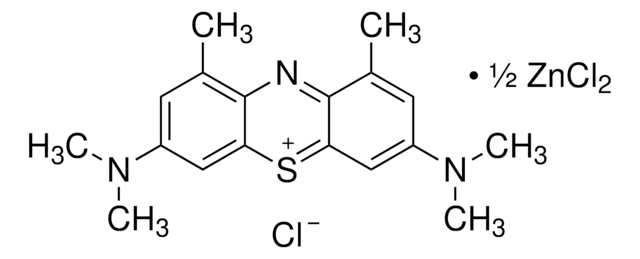Wichtige Dokumente
255246
Kresylviolett
Synonym(e):
Oxazin 9-perchlorat
About This Item
Empfohlene Produkte
Assay
>96.5% (HPLC)
Qualitätsniveau
Form
powder
λmax
602 nm
ε (Extinktionskoeffizient)
≥27000 at 267-273 nm
≥50000 at 599-605 nm
≥7000 at 316-322 nm
Fluoreszenz
λem 602 nm in ethanol
Anwendung(en)
diagnostic assay manufacturing
hematology
histology
Lagertemp.
room temp
SMILES String
OCl(=O)(=O)=O.Nc1cc2OC3=CC(=N)C=CC3=Nc2c4ccccc14
InChI
1S/C16H11N3O.ClHO4/c17-9-5-6-13-14(7-9)20-15-8-12(18)10-3-1-2-4-11(10)16(15)19-13;2-1(3,4)5/h1-8,17H,18H2;(H,2,3,4,5)
InChIKey
YZUJISGZMSLVAU-UHFFFAOYSA-N
Verwandte Kategorien
Allgemeine Beschreibung
Anwendung
Signalwort
Warning
H-Sätze
Gefahreneinstufungen
Eye Irrit. 2 - Skin Irrit. 2 - STOT SE 3
Zielorgane
Respiratory system
Lagerklassenschlüssel
11 - Combustible Solids
WGK
WGK 3
Flammpunkt (°F)
Not applicable
Flammpunkt (°C)
Not applicable
Persönliche Schutzausrüstung
dust mask type N95 (US), Eyeshields, Gloves
Hier finden Sie alle aktuellen Versionen:
Besitzen Sie dieses Produkt bereits?
In der Dokumentenbibliothek finden Sie die Dokumentation zu den Produkten, die Sie kürzlich erworben haben.
Kunden haben sich ebenfalls angesehen
Unser Team von Wissenschaftlern verfügt über Erfahrung in allen Forschungsbereichen einschließlich Life Science, Materialwissenschaften, chemischer Synthese, Chromatographie, Analytik und vielen mehr..
Setzen Sie sich mit dem technischen Dienst in Verbindung.

